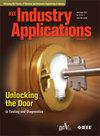A High-Compatibility Wireless Power Transfer System for Autonomous Underwater Vehicles Based on Reconfigurable Magnetic Couplers
IF 4.2
2区 工程技术
Q2 ENGINEERING, ELECTRICAL & ELECTRONIC
引用次数: 0
Abstract
When autonomous underwater vehicles (AUVs) replenish energy through wireless power transfer (WPT) technology on the underwater charging platform, there are practical issues such as excessive transmission gaps and unstable positioning. Additionally, the fixed size of the charging platform leads to insufficient compatibility. This paper proposes a high compatibility WPT system based on a reconfigurable magnetic coupler (RMC) for AUVs replenishing underwater energy. The transmitter of the RMC is combined with the charging platform cage and can follow the charging platform cage in radial dimensions. RMC can provide better coupling performance, and its necessity and effectiveness have been verified through finite element simulation. When the proposed high-compatibility charging platform supplies energy to AUVs of different sizes, the RMC will reconfigure its structure, leading to changes in the transmitter's self-inductance. To address this issue, a switch-controlled capacitor (SCC) method was incorporated into the system to achieve dynamic tuning. Finally, an experimental prototype was built to test the functionality and performance of the proposed RMC structure and SCC method. Compared to existing methods, this approach significantly enhances the practical application capabilities of WPT technology in underwater charging platforms and positively contributes to the cluster deployment of AUVs.基于可重构磁力耦合器的高兼容自主水下航行器无线电力传输系统
自主水下航行器(auv)在水下充电平台上通过无线电力传输(WPT)技术补充能量时,存在传输间隙过大、定位不稳定等现实问题。另外,充电平台的尺寸固定,导致兼容性不足。提出了一种基于可重构磁力耦合器(RMC)的高兼容性水下动力系统,用于水下机器人的水下能量补充。RMC的变送器与装药平台保持架相结合,在径向尺寸上可以跟随装药平台保持架。RMC能够提供更好的耦合性能,并通过有限元仿真验证了其必要性和有效性。当提出的高兼容性充电平台向不同尺寸的auv供电时,RMC会重新配置其结构,从而导致发射器自感的变化。为了解决这一问题,在系统中加入了开关控制电容器(SCC)方法来实现动态调谐。最后,建立了一个实验原型来测试所提出的RMC结构和SCC方法的功能和性能。与现有方法相比,该方法显著增强了WPT技术在水下充电平台中的实际应用能力,对水下机器人的集群部署有积极的贡献。
本文章由计算机程序翻译,如有差异,请以英文原文为准。
求助全文
约1分钟内获得全文
求助全文
来源期刊

IEEE Transactions on Industry Applications
工程技术-工程:电子与电气
CiteScore
9.90
自引率
9.10%
发文量
747
审稿时长
3.3 months
期刊介绍:
The scope of the IEEE Transactions on Industry Applications includes all scope items of the IEEE Industry Applications Society, that is, the advancement of the theory and practice of electrical and electronic engineering in the development, design, manufacture, and application of electrical systems, apparatus, devices, and controls to the processes and equipment of industry and commerce; the promotion of safe, reliable, and economic installations; industry leadership in energy conservation and environmental, health, and safety issues; the creation of voluntary engineering standards and recommended practices; and the professional development of its membership.
 求助内容:
求助内容: 应助结果提醒方式:
应助结果提醒方式:


